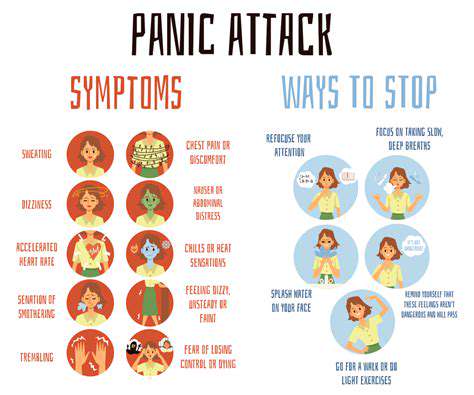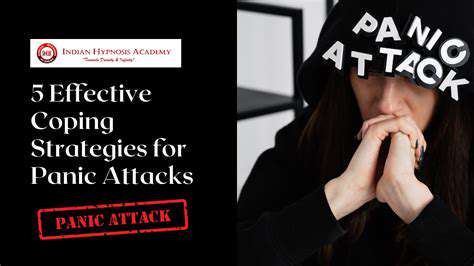Panic Attack Symptoms and Coping Strategies
Common Symptoms of Panic Attacks

Physical Symptoms
Panic attacks can manifest a variety of physical symptoms that can be alarming to those experiencing them. Common symptoms include a racing heart, shortness of breath, and chest pain. These sensations can mimic serious medical conditions, leading to increased anxiety. Additionally, people may experience sweating, trembling, or dizziness during an attack.
Many individuals report feeling as though they are choking or cannot breathe, which can cause further panic. It is essential to understand that these sensations are symptoms of anxiety rather than signs of an impending health crisis. Knowing this can help reduce the fear associated with physical symptoms.
Understanding the physical symptoms can be the first step toward effective management of panic attacks. By recognizing these sensations as temporary and manageable, individuals can begin to gain control over their experiences.
Emotional Symptoms
In addition to physical symptoms, panic attacks can bring about a wide range of emotional responses. Many individuals feel intense fear or a sense of impending doom during an attack. This feeling can make it difficult to think clearly or focus on anything other than the panic.
Sensations of detachment or unreality, known as depersonalization or derealization, may also occur. These feelings can be disorienting and can lead individuals to believe they are losing control of themselves or their surroundings.
Shame or embarrassment often follows a panic attack, especially if it occurs in public. This emotional aftermath can contribute to a cycle of avoidance, wherein individuals shy away from situations they associate with past attacks.
Recognizing these emotional symptoms is crucial for developing coping strategies. By understanding the emotional landscape of a panic attack, individuals can take steps to validate their feelings and work toward alleviating anxiety.
Coping Strategies
Implementing effective coping strategies can significantly decrease the frequency and severity of panic attacks. One essential strategy is mindful breathing, which involves focusing on slow, deep breaths to help calm the nervous system. This technique can help anchor individuals in the present moment when panic begins to rise.
Another effective strategy is to engage in grounding techniques, such as the 5-4-3-2-1 method, which encourages individuals to focus on their surroundings and identify five things they can see, four things they can touch, three things they can hear, two things they can smell, and one thing they can taste.
Physical activity is also a powerful coping strategy, as it releases endorphins that can help improve mood and reduce anxiety levels. Regular exercise can build resilience against stressors that may trigger panic attacks.
Finally, seeking support from friends, family, or mental health professionals can provide individuals with the tools and recommendations they need to cope with panic attacks effectively. Connecting with others who understand their experiences can foster a sense of community and decrease feelings of isolation.
Effective Coping Strategies for Panic Attacks

Understanding the Symptoms of Panic Attacks
Panic attacks can often feel like overwhelming experiences, both emotionally and physically. During an attack, individuals may experience shortness of breath and a racing heartbeat, which can contribute to feelings of impending doom.
Other common symptoms include chest pain, dizziness, and sweating, which can all mimic the signs of a heart attack. This reality can make panic attacks particularly distressing for those who experience them.
It's important to acknowledge that panic attacks can occur unexpectedly, leading to increased anxiety about when the next attack might happen. Understanding these symptoms can help individuals realize that they are not alone in their experiences.
For many, recognizing the triggers can be the first step towards managing panic attacks more effectively. This knowledge empowers individuals to seek necessary support and treatment options.
Effective Coping Strategies for Managing Panic Attacks
One of the most effective coping strategies during a panic attack is practicing deep breathing. Focusing on your breath can help to regulate your heart rate and calm your mind. When you find yourself in the midst of an attack, try inhaling deeply through your nose for a count of four, holding for a count of four, and slowly exhaling through your mouth.
Grounding techniques can also be beneficial. This involves focusing on your surroundings or the sensations in your body, whether it's feeling the texture of an object or observing the colors around you. These techniques help bring your focus back to the present, reducing the intensity of the panic.
Engaging in regular physical activity is another crucial strategy. Exercise can serve as a natural stress reliever and can significantly reduce anxiety levels over time. Activities like yoga or walking also incorporate deep breathing and mindfulness, making them doubly effective.
Finally, seeking professional help can be vital for individuals who frequently experience panic attacks. Therapists can provide specialized strategies and support to help manage symptoms and work towards long-term solutions.